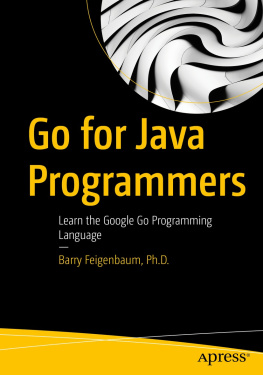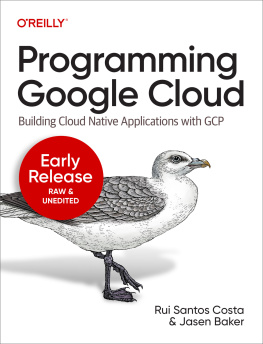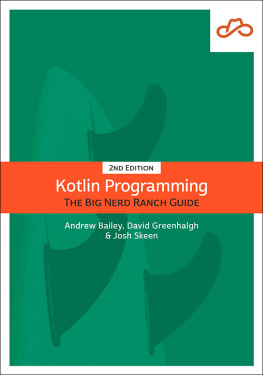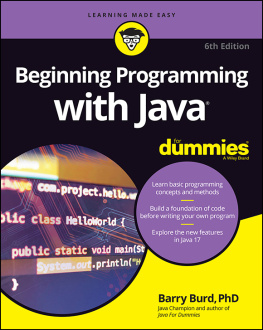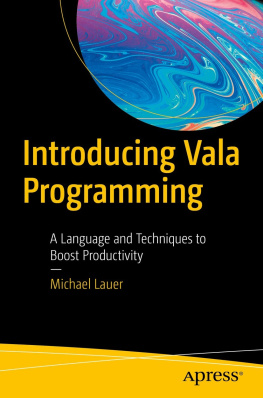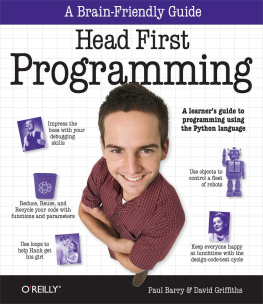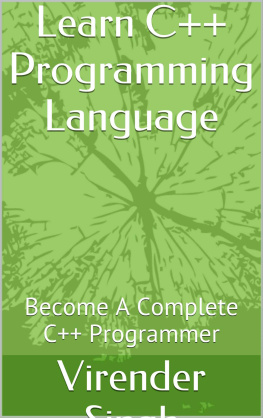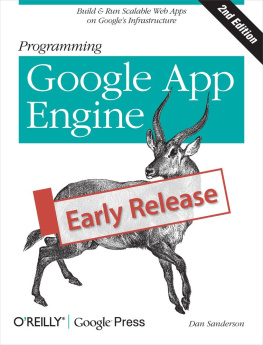Barry Feigenbaum - Learn the Google Go Programming Language
Here you can read online Barry Feigenbaum - Learn the Google Go Programming Language full text of the book (entire story) in english for free. Download pdf and epub, get meaning, cover and reviews about this ebook. year: 2021, publisher: Apress, genre: Home and family. Description of the work, (preface) as well as reviews are available. Best literature library LitArk.com created for fans of good reading and offers a wide selection of genres:
Romance novel
Science fiction
Adventure
Detective
Science
History
Home and family
Prose
Art
Politics
Computer
Non-fiction
Religion
Business
Children
Humor
Choose a favorite category and find really read worthwhile books. Enjoy immersion in the world of imagination, feel the emotions of the characters or learn something new for yourself, make an fascinating discovery.
- Book:Learn the Google Go Programming Language
- Author:
- Publisher:Apress
- Genre:
- Year:2021
- Rating:3 / 5
- Favourites:Add to favourites
- Your mark:
- 60
- 1
- 2
- 3
- 4
- 5
Learn the Google Go Programming Language: summary, description and annotation
We offer to read an annotation, description, summary or preface (depends on what the author of the book "Learn the Google Go Programming Language" wrote himself). If you haven't found the necessary information about the book — write in the comments, we will try to find it.
Learn the Google Go Programming Language — read online for free the complete book (whole text) full work
Below is the text of the book, divided by pages. System saving the place of the last page read, allows you to conveniently read the book "Learn the Google Go Programming Language" online for free, without having to search again every time where you left off. Put a bookmark, and you can go to the page where you finished reading at any time.
Font size:
Interval:
Bookmark:
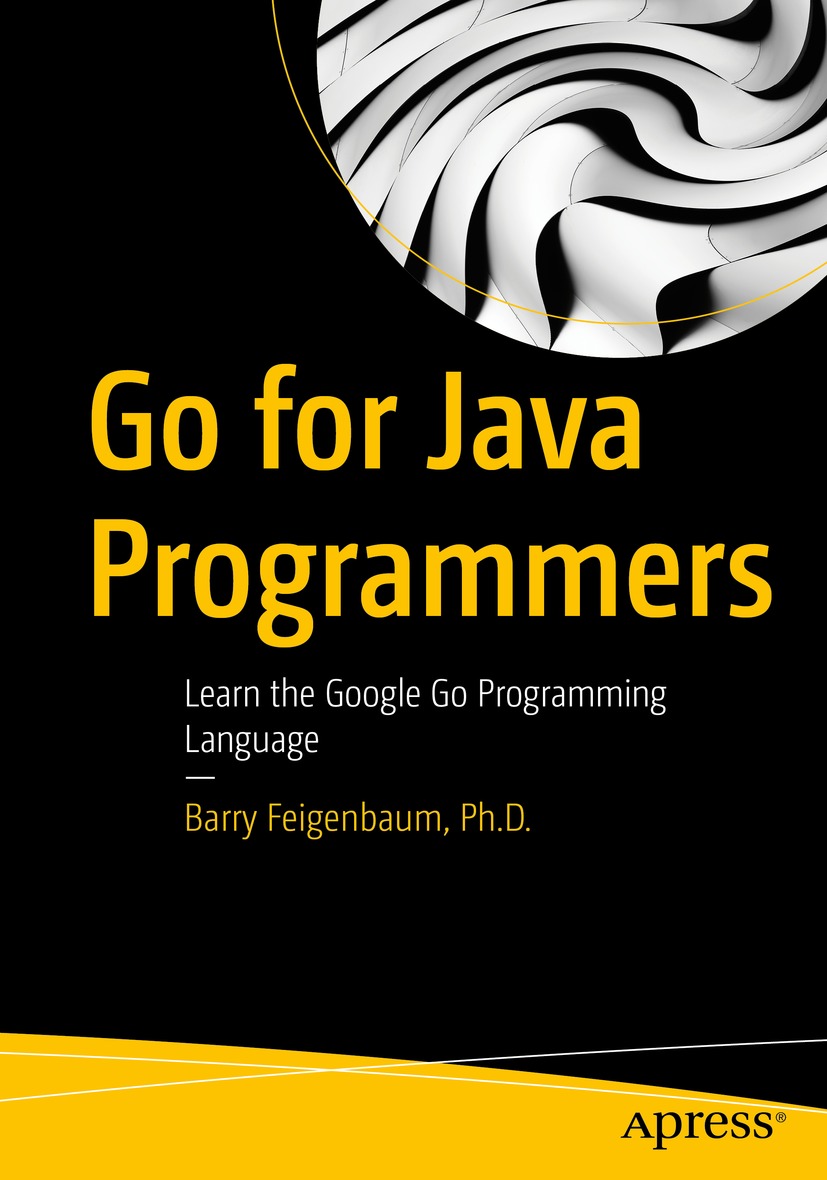

This Apress imprint is published by the registered company APress Media, LLC part of Springer Nature.
The registered company address is: 1 New York Plaza, New York, NY 10004, U.S.A.
To my wife Martha who sustains me.
Thank you for putting up with all the time I spent working on this book.
This book was developed during the Covid-19 pandemic. Many thanks and kudos to all the health-care workers that served so many that became ill and to the essential workers that keep the country going during this time of crisis. My heart goes out to the many who lost friends and loved ones due to Covid-19. May time reduce your pain.
Personally, the stay-at-home nature of this crisis offered me the time needed to author this book, so in some way is it a, hopefully, positive by-product of the pandemic.
Since its debut in the mid-1990s, Java has enjoyed huge success. Arguably more so than other languages, Java is a major player in the web application space and key data processing areas such as Big Data tools, among others. Among other aspects, Javas high level of portability across operating systems and hardware architectures, its rich and improving over time language and library of functions, as well as its good performance contributed to this success.
But Java comes with some drawbacks. Java was created at a time when Object-Oriented Programming Virtual Machine, but typical Java code, for the same functionality, often uses more resources than typical Go code does.
As time is passing, the Java language and runtime is no longer an optimal fit for many modern, especially cloud-based, applications. Also, the Java language is continuously growing and can be a challenge to fully master. Go is deliberately a simple, thus easy to master, language.
The Go language and runtime is relatively new and designed to meet the needs of modern cloud computing systems and other system programming language, the language it most closely resembles. Go is also likely to take over a large fraction of the Java server and application space. Thus, it is the raison d'etre for this book.
Many new applications and reengineering of existing applications are now being developed in Go. For applications previously written in Java, Kotlin its previous Python site implementation. This often happens because Go exhibits many of the ease-of-use features common to scripting languages with the efficiency of compiled languages.
High developer productivity Go offers a consumable and reasonably complete runtime. It also offers a one-stop shopping toolchain. It has widespread high community support.
High readability and developer usability The language itself is small, so it is easy to learn, and its code is both easy to read and understand vs. easiest/fastest to write. It has a targeted ease of use comparable to nonstatically typed languages like Python . Often, the language is opinionated (sort of take it or leave it).
Go uses memory garbage collection (GC) which reduces programmer effort and makes for more reliable programs.
Go is statically linked (vs. dynamically linked, as Java is); this makes it easier to manage deployment and execution of Go programs.
Static typing Generally supports safer, more performant, and more predictable programs; helps with high reliability and long duration execution critical for servers.
Runtime efficiency The code efficiently uses the processors it runs on, comparable to what is achievable in C / C++ applications.
High network performance Distributed/cloud use cases are now common, and the code needs to be performant for them. For the same level of function, Go is often less resource intensive than Java typically is; this helps with reducing resource footprint and improving scale in modern cloud distributions.
High utilization of multi-processor systems The code needs to allow easy and safe exploitation of multi-processor (core) systems that have become the norm. Go excels at this.
Robert Pike summarized this as follows:
we wanted a language with the safety and performance of statically compiled languages such asC++and Java, but the lightness and fun of dynamically typed interpreted languages such asPython. It was also important that the result be suitable for large systems software development on modern, networked, multicore hardware.
The Go Brand Book (GBB) states:
Go isan open source programming language that enables the production of simple, efficient and reliable software at scale.
Developer productivity of a dynamic language with the speed, safety, and reliability of a static language
Easy to learn & readable
Has a vibrant, welcoming community, spanning open-source developers, startups, large companies, and universities
The language for the Cloud
Solves big engineering problems
Backed by Google , who understands and supports needs specific to open source communities and Go
High demand for Go programmers
Font size:
Interval:
Bookmark:
Similar books «Learn the Google Go Programming Language»
Look at similar books to Learn the Google Go Programming Language. We have selected literature similar in name and meaning in the hope of providing readers with more options to find new, interesting, not yet read works.
Discussion, reviews of the book Learn the Google Go Programming Language and just readers' own opinions. Leave your comments, write what you think about the work, its meaning or the main characters. Specify what exactly you liked and what you didn't like, and why you think so.

